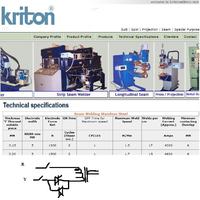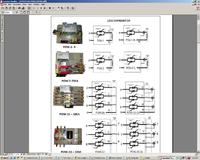umery2k75
Advanced Member level 1

2 phase on TRIAC

We have installed this Seam Welder in our industry. This diagram was made by their engineer who came here. I asked him, why it has more power in two phase compared to single phase and neutral. He said two phase have more power, because this means their are two power sources. I wasn't convienced by that time. Now he's gone.He told me this operates on two phase 120'. I want to know if I apply 1 phase and 1 neutral on the terminal. This is two SCR back to back, a TRIAC.Won't it have greater power, as compared to two phase, because in two phase 120' apart is the problem. it would bring more hinderance, there is smaller limit. in 1 phase and 1 neutral there is no phase angle problem, so current moves freely. In above there's limitation.I have seen welding unit, by which people do electric welding. They are also double phase. I remember one funny incident, when a person puts on it a single phase grinder black and decker on a double phase, he thought the other line was COLD, but both were hot. It burns right on the spot, as soon as he presses the button, hardly turned 2 sec in operation.With smoke comming out from grinder.The concept is that, which is on my brain is that. Suppose you take two wires with 0' out of phase. You get zero power, because no potential difference is their on the terminal. As you increase the phase difference, you get more power.180 I believe is the point where you get the most phase angle difference and most power. Why care about this, when I can put phase,neutral. There's no limitation due to phase angle, because there will be no phase angle issue, as the other line is NEUTRAL.

We have installed this Seam Welder in our industry. This diagram was made by their engineer who came here. I asked him, why it has more power in two phase compared to single phase and neutral. He said two phase have more power, because this means their are two power sources. I wasn't convienced by that time. Now he's gone.He told me this operates on two phase 120'. I want to know if I apply 1 phase and 1 neutral on the terminal. This is two SCR back to back, a TRIAC.Won't it have greater power, as compared to two phase, because in two phase 120' apart is the problem. it would bring more hinderance, there is smaller limit. in 1 phase and 1 neutral there is no phase angle problem, so current moves freely. In above there's limitation.I have seen welding unit, by which people do electric welding. They are also double phase. I remember one funny incident, when a person puts on it a single phase grinder black and decker on a double phase, he thought the other line was COLD, but both were hot. It burns right on the spot, as soon as he presses the button, hardly turned 2 sec in operation.With smoke comming out from grinder.The concept is that, which is on my brain is that. Suppose you take two wires with 0' out of phase. You get zero power, because no potential difference is their on the terminal. As you increase the phase difference, you get more power.180 I believe is the point where you get the most phase angle difference and most power. Why care about this, when I can put phase,neutral. There's no limitation due to phase angle, because there will be no phase angle issue, as the other line is NEUTRAL.


